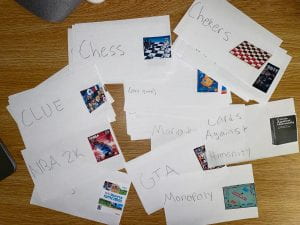In a world of conflict, the Dada movement developed as a daring response to the war, embracing the bizarre and senseless. The chaos of World War I provided fertile ground for the Dadaists’ revolutionary spirit, as they used art to transcend reality’s darkness into a realm of absurdity, satire, and amusement. Using inspiration from this, I appropriated the board game “Headbandz” to craft an experience that serves as a playful counterpoint to the somber undertones of the Dada movement, infusing it with a sense of light-heartedness and pure enjoyment.
My journey began with a desire to harness the Dadaist spirit of rebellion and absurdity, transforming “Headbandz” from a game centered around objects into an ensemble of diverse video and board/card games. Rather than appropriating the tension of war, I aimed to infuse a sense of lightheartedness and fun into the experience. Through the reinterpretation of cards, I have provided a platform for players to escape the weight of reality and immerse themselves in a world that they are familiar with, by reminiscing about some of the most popular games in recent times.
The game works similarly to how “Headbandz” originally works, but instead of guessing random objects players are guessing popular games within recent times. Since this is a games course, I thought appropriating the “Headbandz” game to be about video/board/card games would be fun. Since I wanted the game to fit the lighthearted feel, I tried to think of popular games that everyone would know so players could reminisce once they figured out what their game was. I play-tested it in class as well as in the final iteration and everyone seemed to enjoy guessing and talking about popular games that they played growing up. I got some suggestions about making it a bit faster since it took a decent amount of time to play so I decided to have two game modes, one for a quicker game and one for a longer version. The quicker one would be timed and each player would have 30 seconds to ask as many yes or no questions about their game to try and figure it out. Once the 30 seconds was up, it would move to the next person and repeat the process until someone guessed their game correctly. For the longer version, there would be no timer involved and each player would ask a yes or no question about their game. If the answer to their question was a yes then they would keep asking questions until the answer was no and then it would be the next person’s turn. This process would repeat until everyone guessed their game correctly.

